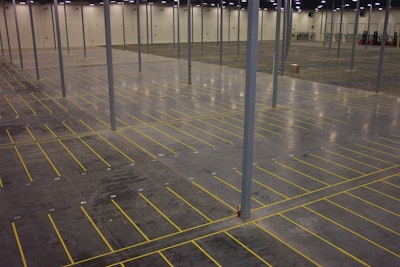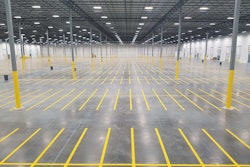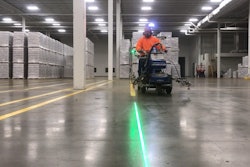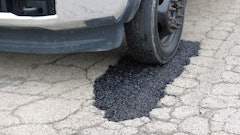
Striping contractors know their target audience. But one thing many contractors may not have considered is extending their services indoors. Places such as warehouses and manufacturing facilities often incorporate striping on their floors for safety areas, aisle marking, or to mark around required open areas such as pallet locations. But many contractors aren't taking advantage of this possible new customer.
Indoor striping can be a great supplement for a striping contractor and might even be a way to extend the season or bring in income on rainy days. "If someone has done parking lot striping - new layout specifically - for a number of years and has learned modern techniques and how to be efficient with the layout they can usually apply the same techniques indoors with a few modifications," says Randy Vorce, owner of Parallel Contracting Inc. in Williamston, MI, which specializes in indoor striping services.
Vorce says it can be tough to find the right market for indoor striping. He suggests targeting property owners, property managers, or companies that may be leasing warehouse properties. "Get on the Internet and start looking and searching for who owns these buildings," Vorce suggests. "Find out who the potential customers are and who the people within those companies are that you need to contact."
Finding the proper avenues to market indoor striping can also be tough, Vorce adds. Word of mouth and direct mailing can be a great way to reach possible customers. Advertising on your company website is another way to get the word out. No matter what paths you choose to market with, the most important aspect is that you put your information out there, Vorce says.
Another way to drum up business for indoor striping is to ask your existing customers, says Dave Laird of Graco. "If they're currently striping exterior space for a customer it's the next step to ask the customer if they have any striping inside that needs to be done," adds Sherwin-Williams Pavement Markings Lead Chemist Chris Fox.
"Not a lot of exterior striping contractors ask the probing questions or inquire about what they could be doing inside," Laird says. It's about asking the customer what else you can do for them. And if a customer isn't sure, Laird suggests doing a free sample for the customer. And stress the quality of line the customer will get from using a professional striping contractor - a lot of indoor striping is often done with in-house help, Laird says.
Once you have a client, keep in touch, says Heath Whitney, partner and owner of Arrow Striping Inc. in Lincoln, NE. Whitney says most indoor striping, depending on floor traffic, will last a year or more before needing to be restriped. So it is always good to check in with your client and see if they are in need of any touch ups or looking to restripe. And don't forget to ask them if they have other facilities that need striping or for referrals. Striping one floor can lead to multiple jobs, Fox says.
The process
Although the indoor striping process is not a huge leap from outdoor striping, there are differences. Most noticeably is the preparation process. Striping contractors may subcontract any striping removal, but they may also choose to do it themselves. Some existing stripes can be removed with a paint remover and a scraper, Vorce says. Another method is shot blasting. This is a great option to remove lines, but it also results in a profiled floor, which many building or property owners don't want, Vorce adds.
Whitney says a contractor can also use a scarifier to lightly grind the top of the floor or a sand blaster. Whitney cautions that sand blasting can create dust and require more thorough cleaning before striping.
One factor pavement striping contractors need to be especially concerned with is if the indoor concrete floor has been sealed. "If you put water on the concrete floor and it soaks in, your concrete is going to be pretty receptive to a coating and may just need cleaning," Laird says. If the water beads that means there is a sealer on the floor that needs to be removed for proper stripe adhesion.
If a floor does not have any existing lines, prep will usually just involve a thorough cleaning. After prep, striping is done basically as it would be outdoors. Vorce suggests finding reference points and premarking the layout before striping. Whitney suggests planning your striping route so you don't end up trapping yourself in a corner.
Sealing the new lines can be done in many ways, or an owner may not want to seal at all. Laird suggests sealing over stripes with a clear coat sealer. The clear coat provides better adhesion of the line to the floor and also extends the life of the line, he says.
Equipment & materials
Contractors can use the same equipment they use for outdoor striping indoors, for the most part.
Because of the detail required, Laird suggests contractors use a walk-behind striper for indoors. Ride-on attachments can be used, but they are harder to turn corners with and may not fit into tight spaces. Vorce also uses a laser on his machine to ensure accuracy during striping.
For materials, contractors can use a water-borne latex traffic marking paint, oil-based paint, industrial enamel, or epoxies, Vorce says. Traffic paint is better suited for an area with little foot or forklift traffic, Whitney suggests. Enamel will hold up better under foot traffic and may have a glossier finish than traffic paint, he adds.
Vorce prefers to use epoxies because of their adhesion and durability. Epoxy will often stand up better to heavier pallets as well as foot and forklift traffic. And, because they don't rely on evaporation of a carrier (solvent) to cure, they are often considered low volatile organic compounds (VOC).
Depending on where a contractor is working there may be VOC requirements affecting material choice. But contractors also need to be aware of the fact that they are working indoors and need proper ventilation. Both Vorce and Fox suggest using water-based paints or epoxies for indoor striping to limit odor and chemicals in the air. This is also a concern when operating equipment. There may be restrictions for using gas powered equipment in the building, Laird says. Always make sure to inquire about this before starting any job. A battery or propane powered striper would be the best option in this situation.
Another concern is floor conditions. "Floor conditions, based on outdoor conditions such as temperatures, affect how we're going to approach a job," Vorce says. Humidity may cause the floor to "sweat." When striping a new concrete floor, contractors also need to be aware of the floor's pH level and if it will be compatible with the materials the contractor will be applying. Laird suggests asking the material supplier for help in determining the pH level and the appropriate materials to use.
Indoor temperature also affects material application. Fox suggests not striping if the building is below 55° F. "Cold paint is much harder to spray and may not cure properly," Fox says. Humidity is a concern as well. "A higher humidity environment will cause the paint to take longer to dry."
Pricing
Pricing indoor striping may be a bit trickier than outdoor striping. But like any business, Vorce says the first step to determine pricing is to know your costs. This includes costs for materials and equipment as well as labor. Contractors also need to consider what type of prep work or finishing work may be involved. From there, determine what the job is worth and how much profit you would like to make. Pricing will often vary from job to job.
Manufacturers and contractors agree that adding indoor striping services to your striping business is not difficult. But there are still points of caution. Vorce says to make sure you understand the service you are getting into including the products you will use and customer expectations. Whitney even suggests including paint reps in client meetings to help explain and choose striping materials.With a bit of research and a good knowledge of the striping industry contractors may find indoor striping as a beneficial service to add to their businesses during both slow and busy times.





















